KIA RIO HATCHBACK 2007 Owner's Guide
Manufacturer: KIA, Model Year: 2007, Model line: RIO HATCHBACK, Model: KIA RIO HATCHBACK 2007Pages: 221, PDF Size: 2.65 MB
Page 31 of 221
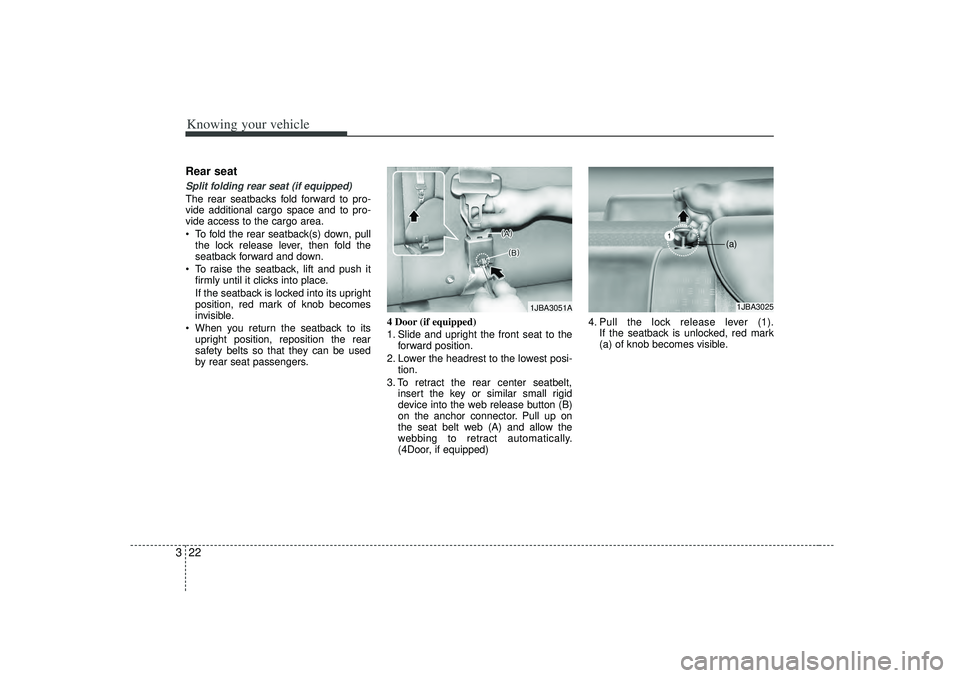
Knowing your vehicle22
3Rear seat Split folding rear seat (if equipped) The rear seatbacks fold forward to pro-
vide additional cargo space and to pro-
vide access to the cargo area.
To fold the rear seatback(s) down, pull
the lock release lever, then fold the
seatback forward and down.
To raise the seatback, lift and push it firmly until it clicks into place.
If the seatback is locked into its upright
position, red mark of knob becomes
invisible.
When you return the seatback to its upright position, reposition the rear
safety belts so that they can be used
by rear seat passengers. 4 Door (if equipped)
1. Slide and upright the front seat to the
forward position.
2. Lower the headrest to the lowest posi- tion.
3. To retract the rear center seatbelt, insert the key or similar small rigid
device into the web release button (B)
on the anchor connector. Pull up on
the seat belt web (A) and allow the
webbing to retract automatically.
(4Door, if equipped) 4. Pull the lock release lever (1).
If the seatback is unlocked, red mark
(a) of knob becomes visible.
1JBA3025(a)
1JBA3051A
Page 32 of 221

323
Knowing your vehicle
5. Move the rear lap/shoulder belt to theoutside (2) so that they don’t interfere
with the seatback when lowering (3).
6. Fold the seatback forward and down firmly (4). 5 Door (if equipped)
1. Set the front seatback to the upright
position and slide the front seat for-
ward.
2. Pull the seat cushion retaining strap (1) and lift the front of the seat cushion.
3. Lift the rear of seat cushion (2). 4. Fold the seat cushion forward firmly
into place (3).
5. Remove the headrest from the rear seatback and stow the headrest by
inserting the headrest poles into the
holes on the bottom of the seat cush-
ion (4).
1JBA30271JBA3028
1JBA35021JBA3503
1JBA35041JBA3505
Page 33 of 221
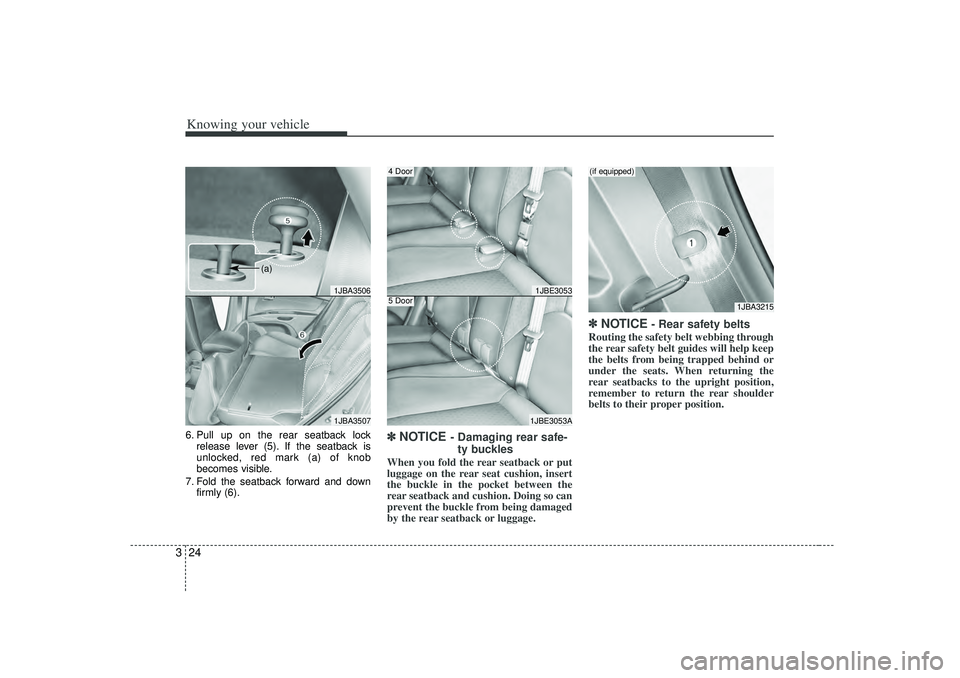
Knowing your vehicle24
36. Pull up on the rear seatback lock
release lever (5). If the seatback is
unlocked, red mark (a) of knob
becomes visible.
7. Fold the seatback forward and down firmly (6).
✽ ✽NOTICE
- Damaging rear safe-
ty buckles
When you fold the rear seatback or put
luggage on the rear seat cushion, insert
the buckle in the pocket between the
rear seatback and cushion. Doing so can
prevent the buckle from being damaged
by the rear seatback or luggage.
✽ ✽ NOTICE
- Rear safety belts
Routing the safety belt webbing through
the rear safety belt guides will help keep
the belts from being trapped behind or
under the seats. When returning the
rear seatbacks to the upright position,
remember to return the rear shoulder
belts to their proper position.
1JBA35061JBA3507
(a)
1JBA3215
(if equipped)
1JBE30531JBE3053A
4 Door5 Door
Page 34 of 221
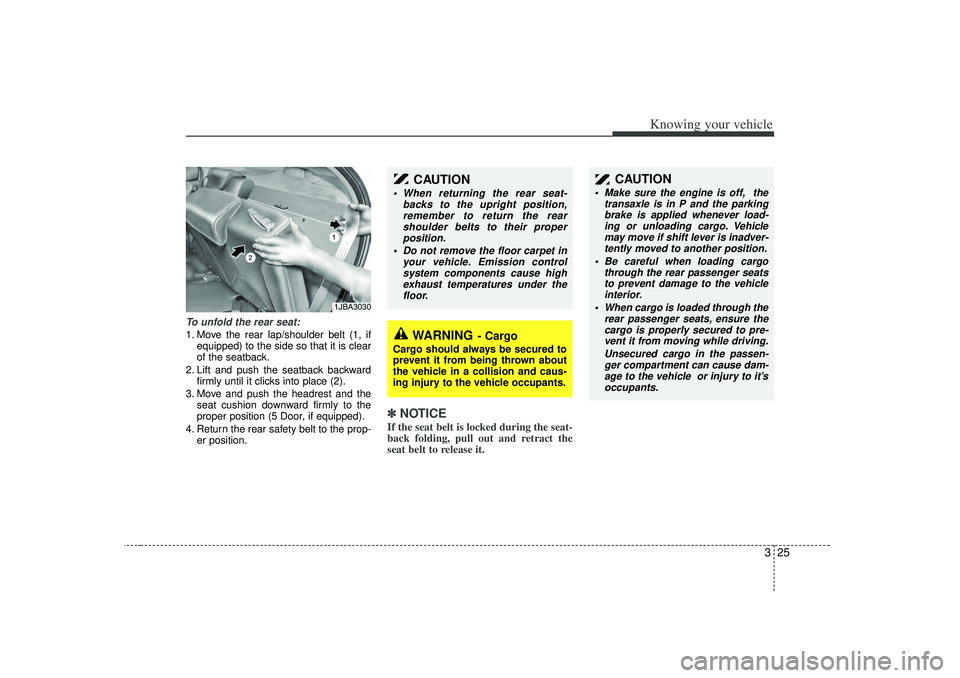
325
Knowing your vehicle
To unfold the rear seat:1. Move the rear lap/shoulder belt (1, ifequipped) to the side so that it is clear
of the seatback.
2. Lift and push the seatback backward firmly until it clicks into place (2).
3. Move and push the headrest and the seat cushion downward firmly to the
proper position (5 Door, if equipped).
4. Return the rear safety belt to the prop- er position.
✽ ✽NOTICEIf the seat belt is locked during the seat-
back folding, pull out and retract the
seat belt to release it.
1JBA3030
CAUTION
When returning the rear seat-
backs to the upright position,remember to return the rearshoulder belts to their proper position.
Do not remove the floor carpet in your vehicle. Emission controlsystem components cause highexhaust temperatures under thefloor.
WARNING
- Cargo
Cargo should always be secured to
prevent it from being thrown about
the vehicle in a collision and caus-
ing injury to the vehicle occupants.
CAUTION
Make sure the engine is off, the transaxle is in P and the parkingbrake is applied whenever load- ing or unloading cargo. Vehiclemay move if shift lever is inadver-tently moved to another position.
Be careful when loading cargo through the rear passenger seatsto prevent damage to the vehicle interior.
When cargo is loaded through the rear passenger seats, ensure thecargo is properly secured to pre-vent it from moving while driving.
Unsecured cargo in the passen-ger compartment can cause dam- age to the vehicle or injury to it’soccupants.
Page 35 of 221
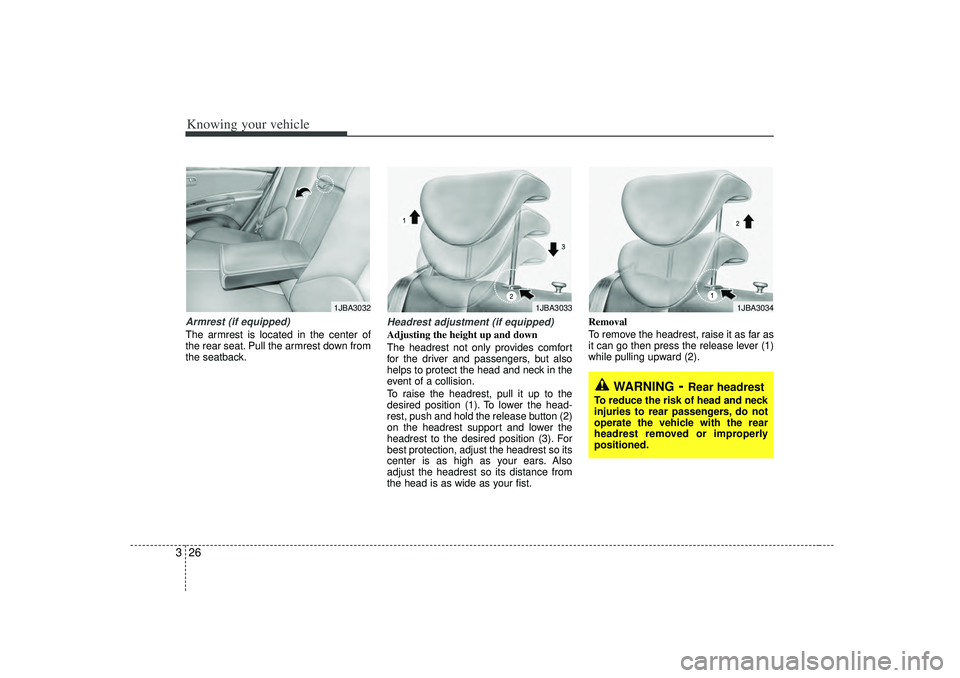
Knowing your vehicle26
3Armrest (if equipped)The armrest is located in the center of
the rear seat. Pull the armrest down from
the seatback.
Headrest adjustment (if equipped)Adjusting the height up and down
The headrest not only provides comfort
for the driver and passengers, but also
helps to protect the head and neck in the
event of a collision.
To raise the headrest, pull it up to the
desired position (1). To lower the head-
rest, push and hold the release button (2)
on the headrest support and lower the
headrest to the desired position (3). For
best protection, adjust the headrest so its
center is as high as your ears. Also
adjust the headrest so its distance from
the head is as wide as your fist. Removal
To remove the headrest, raise it as far as
it can go then press the release lever (1)
while pulling upward (2).
1JBA3032
1JBA3033
1JBA3034
WARNING
- Rear headrest
To reduce the risk of head and neck
injuries to rear passengers, do not
operate the vehicle with the rear
headrest removed or improperly
positioned.
Page 36 of 221

327
Knowing your vehicle
Pre-tensioner seat belt
(if equipped)Your vehicle is equipped with driver's and
front passenger's pre-tensioner safety
belts. The purpose of the pre-tensioner
is to make sure that excess slack is taken
up in certain frontal collisions. The pre-
tensioner seat belts will activate together
with the air bags, where the frontal colli-
sion is severe enough.The seat belt pre-tensioner system con-
sists mainly of the following components.
Their locations are shown in the illustra-
tion.
(1) SRS air bag warning light
(2) Seatbelt pre-tensioner assembly
(3) SRS air bag control moduleSAFETY BELTS
2GHB3002
CAUTION
Both the driver's and front passen-
ger's pre-tensioner seat belts willbe activated in certain frontal colli- sions. The pre-tensioner seat beltscan be activated, where the frontalcollision is severe enough, togetherwith the air bag. The pre-tensionerswill be activated under these condi- tions even if there is no one on theseat at the time of the collision.
1LDE3100
1
2
3
Page 37 of 221
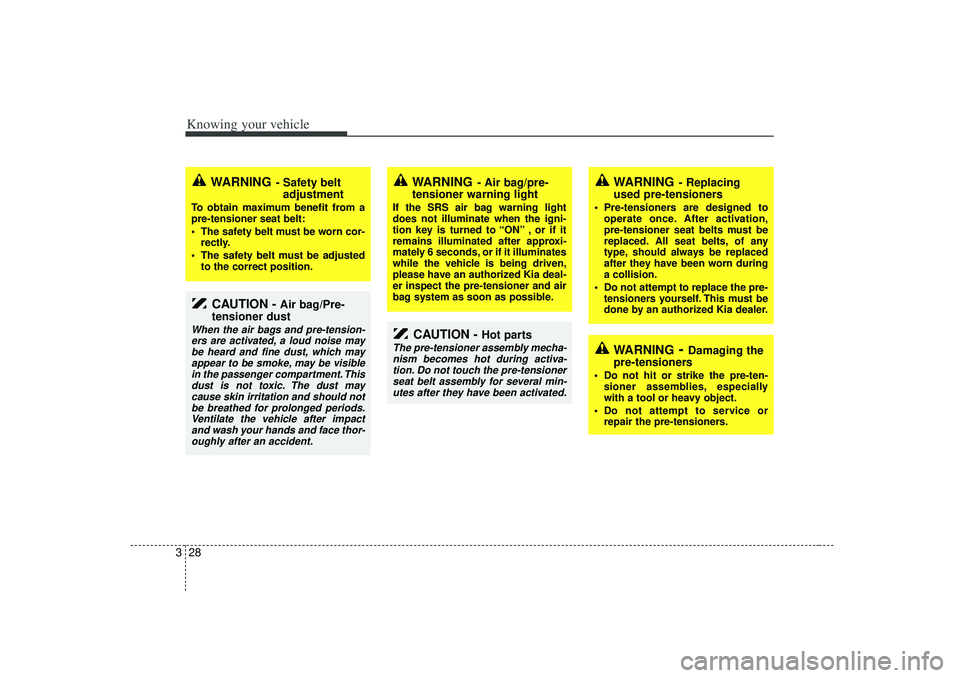
Knowing your vehicle28
3
CAUTION -
Air bag/Pre-
tensioner dust
When the air bags and pre-tension-
ers are activated, a loud noise may be heard and fine dust, which mayappear to be smoke, may be visiblein the passenger compartment. Thisdust is not toxic. The dust may cause skin irritation and should notbe breathed for prolonged periods.Ventilate the vehicle after impact and wash your hands and face thor-oughly after an accident.
WARNING
- Air bag/pre-
tensioner warning light
If the SRS air bag warning light
does not illuminate when the igni-
tion key is turned to “ON” , or if it
remains illuminated after approxi-
mately 6 seconds, or if it illuminates
while the vehicle is being driven,
please have an authorized Kia deal-
er inspect the pre-tensioner and air
bag system as soon as possible.
WARNING
- Safety belt adjustment
To obtain maximum benefit from a
pre-tensioner seat belt:
The safety belt must be worn cor-
rectly.
The safety belt must be adjusted to the correct position.
WARNING
- Replacing
used pre-tensioners
Pre-tensioners are designed to
operate once. After activation,
pre-tensioner seat belts must be
replaced. All seat belts, of any
type, should always be replaced
after they have been worn during
a collision.
Do not attempt to replace the pre- tensioners yourself. This must be
done by an authorized Kia dealer.
CAUTION -
Hot parts
The pre-tensioner assembly mecha-nism becomes hot during activa-tion. Do not touch the pre-tensionerseat belt assembly for several min- utes after they have been activated.
WARNING
- Damaging the
pre-tensioners
Do not hit or strike the pre-ten-
sioner assemblies, especially
with a tool or heavy object.
Do not attempt to service or repair the pre-tensioners.
Page 38 of 221
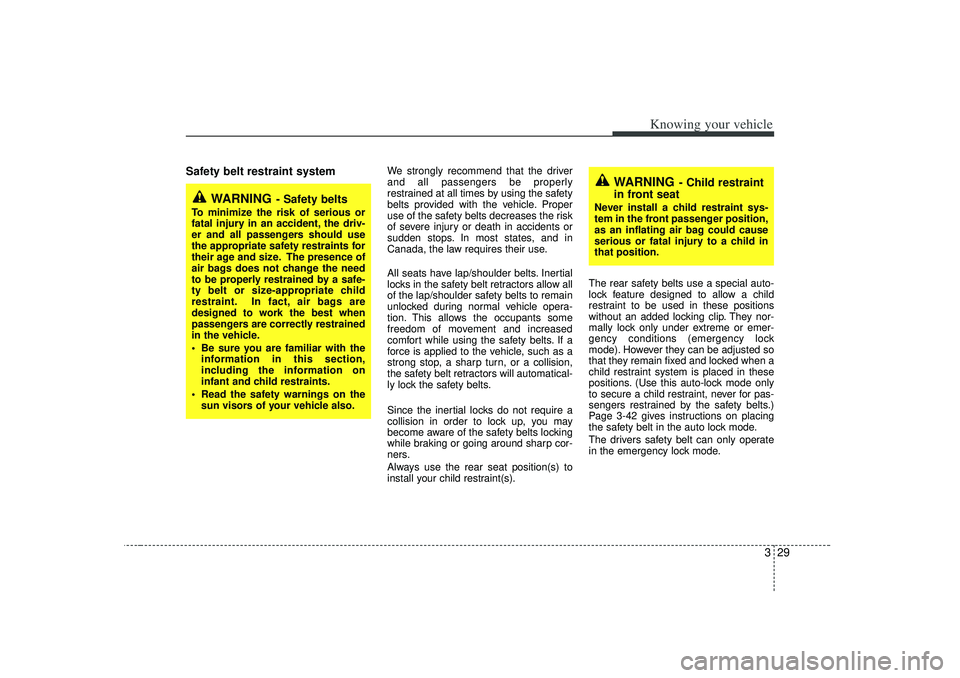
329
Knowing your vehicle
Safety belt restraint system
We strongly recommend that the driver
and all passengers be properly
restrained at all times by using the safety
belts provided with the vehicle. Proper
use of the safety belts decreases the risk
of severe injury or death in accidents or
sudden stops. In most states, and in
Canada, the law requires their use.
All seats have lap/shoulder belts. Inertial
locks in the safety belt retractors allow all
of the lap/shoulder safety belts to remain
unlocked during normal vehicle opera-
tion. This allows the occupants some
freedom of movement and increased
comfort while using the safety belts. If a
force is applied to the vehicle, such as a
strong stop, a sharp turn, or a collision,
the safety belt retractors will automatical-
ly lock the safety belts.
Since the inertial locks do not require a
collision in order to lock up, you may
become aware of the safety belts locking
while braking or going around sharp cor-
ners.
Always use the rear seat position(s) to
install your child restraint(s).The rear safety belts use a special auto-
lock feature designed to allow a child
restraint to be used in these positions
without an added locking clip. They nor-
mally lock only under extreme or emer-
gency conditions (emergency lock
mode). However they can be adjusted so
that they remain fixed and locked when a
child restraint system is placed in these
positions. (Use this auto-lock mode only
to secure a child restraint, never for pas-
sengers restrained by the safety belts.)
Page 3-42 gives instructions on placing
the safety belt in the auto lock mode.
The drivers safety belt can only operate
in the emergency lock mode.
WARNING
- Safety belts
To minimize the risk of serious or
fatal injury in an accident, the driv-
er and all passengers should use
the appropriate safety restraints for
their age and size. The presence of
air bags does not change the need
to be properly restrained by a safe-
ty belt or size-appropriate child
restraint. In fact, air bags are
designed to work the best when
passengers are correctly restrained
in the vehicle.
Be sure you are familiar with the
information in this section,
including the information on
infant and child restraints.
Read the safety warnings on the sun visors of your vehicle also.
WARNING
- Child restraint
in front seat
Never install a child restraint sys-
tem in the front passenger position,
as an inflating air bag could cause
serious or fatal injury to a child in
that position.
Page 39 of 221
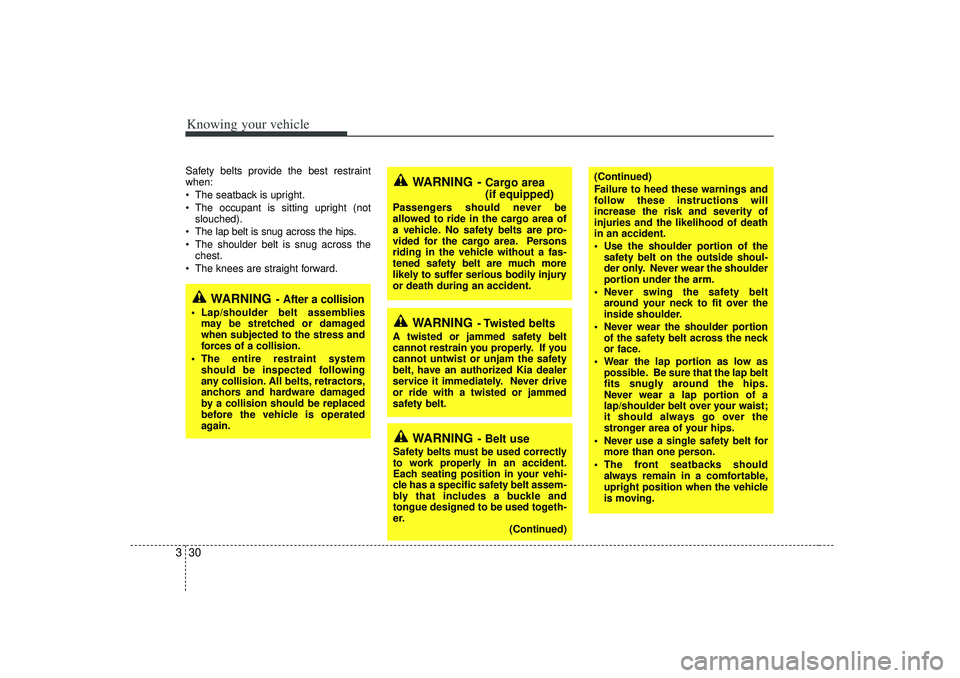
Knowing your vehicle30
3
(Continued)
Failure to heed these warnings and
follow these instructions will
increase the risk and severity of
injuries and the likelihood of death
in an accident.
Use the shoulder portion of the
safety belt on the outside shoul-
der only. Never wear the shoulder
portion under the arm.
Never swing the safety belt around your neck to fit over the
inside shoulder.
Never wear the shoulder portion of the safety belt across the neck
or face.
Wear the lap portion as low as possible. Be sure that the lap belt
fits snugly around the hips.
Never wear a lap portion of a
lap/shoulder belt over your waist;
it should always go over the
stronger area of your hips.
Never use a single safety belt for more than one person.
The front seatbacks should always remain in a comfortable,
upright position when the vehicle
is moving.
Safety belts provide the best restraint
when:
The seatback is upright.
The occupant is sitting upright (not
slouched).
The lap belt is snug across the hips.
The shoulder belt is snug across the chest.
The knees are straight forward.
WARNING
- After a collision
Lap/shoulder belt assemblies may be stretched or damaged
when subjected to the stress and
forces of a collision.
The entire restraint system should be inspected following
any collision. All belts, retractors,
anchors and hardware damaged
by a collision should be replaced
before the vehicle is operated
again.
WARNING -
Cargo area
(if equipped)
Passengers should never be
allowed to ride in the cargo area of
a vehicle. No safety belts are pro-
vided for the cargo area. Persons
riding in the vehicle without a fas-
tened safety belt are much more
likely to suffer serious bodily injury
or death during an accident.
WARNING
- Twisted belts
A twisted or jammed safety belt
cannot restrain you properly. If you
cannot untwist or unjam the safety
belt, have an authorized Kia dealer
service it immediately. Never drive
or ride with a twisted or jammed
safety belt.
WARNING
- Belt use
Safety belts must be used correctly
to work properly in an accident.
Each seating position in your vehi-
cle has a specific safety belt assem-
bly that includes a buckle and
tongue designed to be used togeth-
er. (Continued)
Page 40 of 221
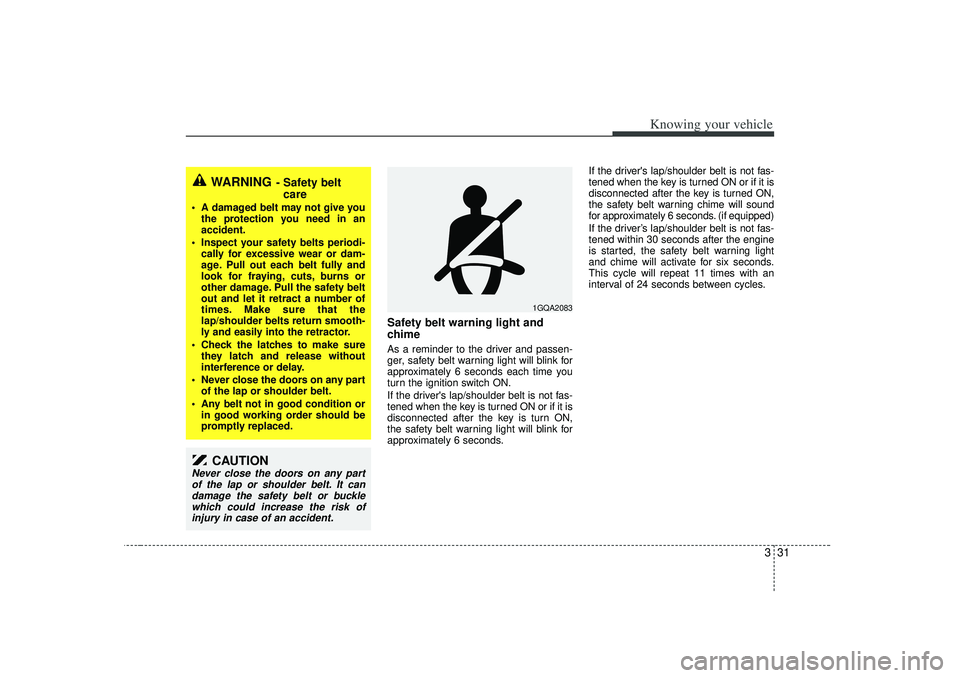
331
Knowing your vehicle
Safety belt warning light and
chimeAs a reminder to the driver and passen-
ger, safety belt warning light will blink for
approximately 6 seconds each time you
turn the ignition switch ON.
If the driver's lap/shoulder belt is not fas-
tened when the key is turned ON or if it is
disconnected after the key is turn ON,
the safety belt warning light will blink for
approximately 6 seconds.If the driver's lap/shoulder belt is not fas-
tened when the key is turned ON or if it is
disconnected after the key is turned ON,
the safety belt warning chime will sound
for approximately 6 seconds. (if equipped)
If the driver’s lap/shoulder belt is not fas-
tened within 30 seconds after the engine
is started, the safety belt warning light
and chime will activate for six seconds.
This cycle will repeat 11 times with an
interval of 24 seconds between cycles.
WARNING
- Safety belt
care
A damaged belt may not give you
the protection you need in an
accident.
Inspect your safety belts periodi- cally for excessive wear or dam-
age. Pull out each belt fully and
look for fraying, cuts, burns or
other damage. Pull the safety belt
out and let it retract a number of
times. Make sure that the
lap/shoulder belts return smooth-
ly and easily into the retractor.
Check the latches to make sure they latch and release without
interference or delay.
Never close the doors on any part of the lap or shoulder belt.
Any belt not in good condition or in good working order should be
promptly replaced.
CAUTION
Never close the doors on any partof the lap or shoulder belt. It candamage the safety belt or buckle which could increase the risk ofinjury in case of an accident.
1GQA2083